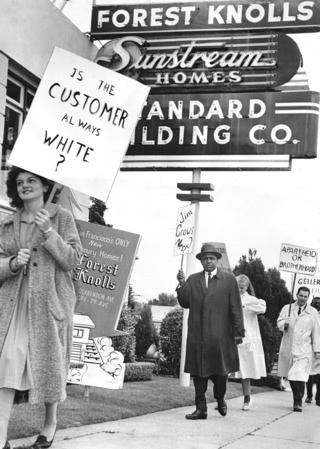Fielder's Choice - Page 4
According to Ebony, the site was so steep "eight architects, even though accustomed to California's modern habit of cliff dwelling, said it couldn't be done. A ninth did it, and the angular house now stands on two steel-and-concrete beams, placed at diagonals under it." The clever architect was Kent Linn, who is still practicing in Oakland.
Mays brought in an interior designer, but did much of the design himself, choosing the colors, gold and white, with blue accents in the master bedroom. "I don't like a lot of colors," Mays told writer Louie Robinson.
The home had a spiral staircase—and a king-size bed. "I like plenty of room to thrash around," Mays said.
 |
 |
|
|
"Unlike discriminatory difficulties Mays and his ex-wife faced when they bought their first San Francisco home in 1958," Ebony noted in a photo caption, "purchase of the second home was frictionless."
Photos: courtesy San Francisco History Center (S.F. Public Library), A. Quincy Jones Papers (Special Collections - Young Research Library, UCLA), Ebony magazine, Rico Tee Collection
• Willie Mays' first home in San Francisco can still be seen at 175 Miraloma Drive. His bachelor pad is at 54 Mendosa Avenue.
Discrimination strikes another Willie
Housing discrimination on the basis of race remained legal in California until the passage of the Fair Housing Act in 1963.
Another famous Willie, politician Willie Brown, did his best in May 1961 to end the practice in San Francisco. He staged an incident that recalled the one that faced Willie Mays.
Brown, a young lawyer and an activist with the NAACP, and his wife Blanche, accompanied by their two young children, the "picture of a professional, middle-class family," were turned away from a home built in the Forest Knolls neighborhood by Carl and Fred Gellert's Standard Building Co., one of the biggest builders in Northern California.
James Richardson, author of Willie Brown: A Biography, calls what happened next "well planned, brilliantly executed political theater," as the press watched as the Forest Knolls sales office shut down rather than let the Browns in.
Days of protest followed, pulling in supporters ranging from future mayor Dianne Feinstein to jazz pianist Oscar Peterson.
While Brown succeeded in bringing the shame of racial discrimination before a wide audience, he did not succeed in buying a house in Forest Knolls. And the board of supervisors did not pass legislation banning discrimination.
- « first
- ‹ previous
- 1
- 2
- 3
- 4




